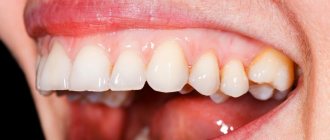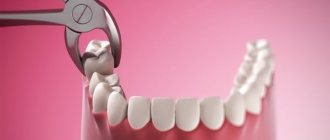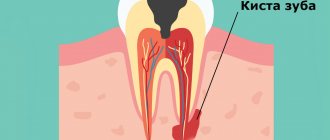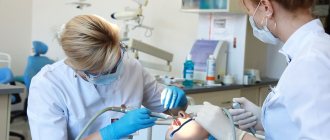Author of the article:
Soldatova Lyudmila Nikolaevna
Candidate of Medical Sciences, Professor of the Department of Clinical Dentistry of the St. Petersburg Medical and Social Institute, Chief Physician of the Alfa-Dent Dental Clinic, St. Petersburg
Let's figure out how to determine that gum inflammation has begun after tooth extraction, how to quickly get rid of it and prevent its occurrence.
What to do after wisdom tooth removal
On this day, it is better to go home and relax: sleep, read a book, watch your favorite show or movie. It is not recommended to move a lot and intensively, or engage in physical labor.
Starting from the second day, it is necessary to rinse your mouth with antiseptics and take antibiotic medications to prevent the development of infectious and inflammatory diseases. The doctor decides which antibiotics to take after wisdom tooth removal. If there are no recommendations, then you can choose any medications with a wide spectrum of action.
Intense rinsing is not recommended, licking the blood clot is strictly prohibited, otherwise this will lead to the effect of a dry socket. A plug of clotted blood protects the resulting cavity and jaw bones from food particles and bacteria getting inside.
Do not consume hot or too cold foods, drinks, or overheat the body. Visiting the beach, baths, saunas is prohibited.
Smokers will have to give up cigarettes for 2, 3 days, or better yet for a week. Nicotine does not allow the wound to heal quickly, as it constricts blood vessels. Tissues are poorly saturated with oxygen and nutrients, and are more easily susceptible to infection.
A repeated visit to the doctor is necessary, even if the stitches do not need to be removed. The doctor will examine the wound, be able to identify complications in time and prescribe the correct treatment. You should not wait until the date of re-appointment if there is severe, ongoing pain, or the appearance of pus in the socket.
Types of inflammation
The most common types of inflammation that occur after tooth extraction are:
- Alveolitis is an inflammation of the walls of the empty socket of an extracted tooth. The patient suffers from swelling, redness, and “tugging” pain. Weakness, malaise appear, and body temperature rises.
- Gingivitis is inflammation caused by tooth extraction. The tissues turn red, begin to swell and bleed.
- Periostitis is an inflammation of the jaw bone (periosteum). The disease is characterized by severe toothache, swelling of the gums, gumboil, and distortion of the facial contour. Pathological mobility of the tooth appears, lymph nodes are palpated in the face and neck.
- Periodontitis is inflammation of the periodontium, the area around the root of the tooth. The disease is characterized by aching or sharp pain in the tooth, which intensifies when biting. Without treatment, the pain gradually turns into throbbing, tearing pain. The patient complains of severe weakness, fever, and sleep disturbances.
- Trauma to the gums from dental fragments. With mechanical damage to tissues, swelling, redness appear, and spontaneous pain begins, intensifying when touched. If the injury persists for a long time, a dark pressure ulcer with purulent and serous discharge may form at the site of injury.
If your temperature rises after wisdom tooth removal
The symptom may occur immediately after extirpation. This is due to the action of the immune system in response to tissue injury and invasion of foreign elements into the body.
Doctors recommend taking antipyretics and using cold compresses to remove heat locally.
If the patient then develops a fever several days after extirpation, this may indicate the presence of an inflammatory process. The most common is alveolitis. It is accompanied by acute pain, which can radiate to the throat, temple, ear, depending on where the hole is located. If, when you probe the hole with your tongue, you feel an empty cavity, then you need to urgently go to the dental clinic where the surgery was performed.
Classification
Depending on the nature of the healing of the hole, dentists distinguish several main forms of dental alveolitis:
- Serous. The initial stage of the disease usually appears 2–3 days after tooth extraction. This form is characterized by continuous pain that worsens while eating. Although the patient does not yet complain of feeling unwell, his lymph nodes are not enlarged, but he already feels that the disease is progressing.
- Purulent. If the serous form of alveolitis is not treated, the disease turns into a purulent form. Most often it is diagnosed 6–7 days after tooth extraction. The painful sensations can no longer be ignored, the pain intensifies, radiating to the ear or temple. Exploring the affected area also causes severe pain. Purulent alveolitis is characterized by a dirty gray coating inside the socket, significant swelling around the wound, thickened alveolar process and other problems. The patient's general health deteriorates significantly. Lymph nodes enlarge and become painful on palpation. Often the patient cannot even eat or open his mouth.
- Hypertrophic. At this stage, the symptoms of the disease subside. The patient notes a decrease in body temperature, improved well-being and decreased pain. However, at the hypertrophic stage, dangerous tissue proliferation occurs, which is clearly visible upon examination. When touched, pus is released from the inflamed area, and the mucous membrane acquires a bluish tint.
Ask a Question
How to relieve pain after wisdom tooth removal
The doctor prescribes drugs for pain relief to the patient. If there is no list, but the pain is severe, then you can buy Tempalgin, Baralgin, Ketanov and similar medications. Medicines must be taken according to instructions. If you take too many tablets, it will lead to side effects. One tablet is usually enough to stop an attack. Take three times a day.
In addition to medications, pain can be reduced with cold. A cold compress is applied to the cheek for 15 to 30 minutes up to four times a day. You can use pieces of ice or frozen food from the freezer. They are placed in a plastic bag and a towel, and then applied to the sore spot.
Tooth extraction: swelling
Tooth extraction is a difficult operation that traumatizes the tissue surrounding the tooth. Therefore, it is not surprising that unpleasant consequences occur after tooth extraction: the most common of them is swelling. Patients often complain that after tooth extraction, the gums become swollen, swelling of the cheek or a slight gumboil appears. This is caused by partial destruction of the soft tissue around the tooth. This is unpleasant, but if the tumor is small, it goes away on its own in 2-3 days. To relieve swelling after tooth extraction, ice can be applied to the cheek for about 10 minutes. If the swelling has not gone away after a day, apply heat. Keep the heating pad for 20 minutes, then take a break for 10 minutes and put the heating pad back on.
Sometimes swelling can be caused by an allergy to the anesthesia. In this case, histamine, an antiallergic drug, will help. But if the swelling increases, then it may be a sign of inflammation that has arisen after tooth extraction. In this case, you should immediately consult a doctor.
What can you eat after wisdom tooth removal?
It is forbidden to put anything in your mouth for two hours after extraction. During this time, a plug of condensed blood is formed and fixed on the socket, which is necessary to protect against the entry of various elements, including pathogens. If you are very thirsty, you can do this through a straw or in small sips.
On the first day, you can drink non-hot drinks and eat liquid porridge, yogurt, and soups. Over the next few days, you should adhere to the following recommendations:
- food must be at a comfortable temperature; hot and too cold food is prohibited, including drinks;
- it is necessary to exclude solid foods that can injure the gums;
- You need to chew food on the side that has not undergone surgery;
- After each dose, you need to rinse your mouth with a warm saline solution;
- If your immune system is weakened, you can take additional multivitamins.
It is better to refuse or limit sweet, spicy foods, alcohol, and carbonated drinks.
Prevention
The best prevention of pathology after tooth extraction is to be attentive to yourself and follow all the surgeon’s recommendations. While the hole is healing, give up bad habits, eating too hot, spicy, sweet foods, and if possible, switch to pureed foods. And if you suspect inflammation, contact your dentist as soon as possible.
Under no circumstances should the first symptoms of alveolitis be ignored. Against the background of inflammation, more serious problems may arise:
- Phlegmon is an acute diffuse purulent inflammation.
- An abscess is a purulent inflammation of tissues with their melting.
- Osteomyelitis is a purulent-necrotic process that can develop in the bone and bone marrow, as well as in the surrounding soft tissues.
- Periostitis is inflammation of the periosteum.
- Sepsis is a severe systemic inflammatory reaction.
- Tissue necrosis is local tissue death.
Modern methods of treating alveolitis make it possible to quickly relieve the symptoms of inflammation and avoid the complex consequences of the disease. The sooner the patient consults a doctor, the less likely it is to develop complications.
How to rinse your mouth after wisdom tooth removal
The first few hours after extirpation, rinsing is strictly prohibited. This can lead to the natural plug being washed away, exposing the socket and bone. If bacteria penetrate inside, alveolitis or osteomyelitis will develop.
From the second day, carefully, not intensively, rinse your mouth with various antiseptics:
- chlorhexidine;
- miramestin;
- furatsilin;
- diluted potassium permanganate.
At home, you can prepare a solution with salt, soda, and add a few drops of iodine to the water. Herbal decoctions with sage, eucalyptus, chamomile, calendula, and oak bark perfectly relieve swelling and inflammation.
Is it always necessary to remove a wisdom tooth?
No! A wisdom tooth can erupt without problems if there is enough space in the dentition. If it is correctly and evenly located in the dentition, does not injure the mucous membrane of the gums and cheeks, and does not injure the adjacent molar, then there is no need to remove it. This is a full-fledged tooth involved in the act of chewing.
Sometimes, after complete eruption, the wisdom tooth remains partially covered by the mucous membrane, a “hood”, under which bacterial plaque can accumulate. Due to poor hygiene in this area, inflammation of the gum covering the tooth may occur. If the gum above the wisdom tooth hurts, it is enough to simply remove it (remove the hood).
Any tooth in the oral cavity has its own antagonist, i.e. a similar tooth on the opposite jaw, with which they should close. This allows the teeth to participate in chewing and be cleaned while eating. Wisdom teeth often do not have antagonists (for example, the lower molars have erupted but the upper ones have not). In this situation, it is recommended to remove these teeth. Why? The fact is that if a tooth does not have an antagonist, it does not participate in the act of chewing and in the process of eating it will not be cleared of bacterial plaque and very quickly caries will form on it, which is very difficult to cure (for the patient, since it is necessary to very widely and keep your mouth open for a long time).
Preservation of a wisdom tooth and its treatment are possible in the absence of contraindications, good mouth opening and the patient’s strong desire.
One of the indications for preserving a wisdom tooth is the absence of the seventh or sixth teeth (first and second molars), removed in early childhood for various reasons. In this situation, the orthodontist can move the eighth tooth to the area of the missing ones, maintaining the continuity of the dentition. Moving teeth (especially chewing ones) is a long process. It is best to start it before the full eruption of the wisdom tooth.
How long does it take for gums to heal after wisdom tooth removal?
It is impossible to answer this question unambiguously, since the answer depends on the following factors:
- difficulties of extirpation - with a simple procedure, the tissues are minimally injured, which means the hole will heal within a few days; with incisions in the gums, the tissues heal for several weeks;
- age - faster for young people;
- the presence of complications, inflammatory processes that delay healing indefinitely until the infection is eliminated;
- compliance with doctor's instructions for the rehabilitation period;
- individual characteristics of the body.
Treatment of inflammation
Treatment of gum inflammation after tooth extraction depends on the disease that arose during the operation. If a problem is suspected, the patient is advised to consult a doctor. An experienced dentist will determine the nature of the inflammation and prescribe proper treatment.
- In case of alveolitis, tissue curettage is performed, all contents are scraped out of the hole, and the tissues are sanitized. The doctor places a swab with an antiseptic on the wound.
- Periostitis is usually treated surgically. The doctor opens the rotting lesions and carries out medical treatment using anti-inflammatory, painkillers and antibiotics.
- Gingivitis requires the removal of tartar, normalization of oral hygiene and gum care using special rinses.
- For periodontitis, complex treatment is carried out using antibiotics, antiseptics, as well as anti-inflammatory and painkillers.
- Broken tooth fragments are removed by a surgeon; rinses, applications, and baths with antiseptics can be used to relieve inflammation.
Sometimes, for inflammation of the gums after tooth extraction, the patient is prescribed physiotherapeutic procedures, for example, exposure to a helium-neon laser, a course of fluctuarization. Also, gums can become inflamed after brushing your teeth.
With proper treatment of gum inflammation after tooth extraction, the socket is restored in about 10 days, and the outbreak itself disappears within two weeks.











